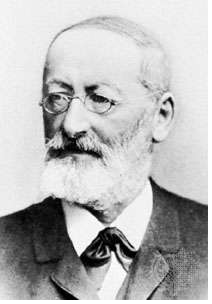Ferdinand Cohn, a German biologist was born in Breslau (now in Poland). Cohn was the first to classify algae (a type of microorganism), and he is also one of the founders of modern microbiology and bacteriology. Ferdinand Cohn successfully distinguished algae from plants, and he also classified bacteria into four (4) different groups in terms of their characteristic shapes (rods, spirals, spherical and threads); a bacterial classification which is still in use in bacteriology till date.
Cohn is one of the founding fathers of the field of bacteriology, and he also provided a basis for the classification of bacteria. He was trained as a botanist and became an excellent microscopist, and this led him to study algae (unicellular plant-like microorganisms) and later, photosynthetic bacteria. Cohn believed that all bacteria were members of the plant kingdom. He discovered that bacteria multiply by dividing into two cells (a process known as binary fission), and that certain bacteria form an extremely resistant structure called endospore in the cell. His work and interest in heat resistant bacteria has led us to know about bacterial endospores.
He described the entire life cycle of the endospore forming bacteria, Bacillus (vegetative cell – endospore – vegetative cell), and discovered that the vegetative form of this bacteria was killed by heating, but their endospores were not killed in the process of heating. His work in this area of heat resistant forms of bacteria helped his contemporaries as at the time to know why boiling is an unreliable means of preventing fluid infusions from supporting microbial growth.
Cohn is credited with the use of cotton plugs for closing flasks and tubes to prevent the contamination of sterile culture media in the early 1860s. Ferdinand Cohn also studied the large sulphur bacterium, Beggiatoa mirabilis and was the first to identify the small granules present in the cells that are made of sulphur (which are produced from the oxidation of hydrogen sulphide, H2S).
References
Barrett J.T (1998). Microbiology and Immunology Concepts. Philadelphia, PA: Lippincott-Raven Publishers. USA.
Beck R.W (2000). A chronology of microbiology in historical context. Washington, D.C.: ASM Press.
Brooks G.F., Butel J.S and Morse S.A (2004). Medical Microbiology, 23rd edition. McGraw Hill Publishers. USA. Pp. 248-260.
Chung K.T, Stevens Jr., S.E and Ferris D.H (1995). A chronology of events and pioneers of microbiology. SIM News, 45(1):3–13.
Slonczewski J.L, Foster J.W and Gillen K.M (2011). Microbiology: An Evolving Science. Second edition. W.W. Norton and Company, Inc, New York, USA.
Summers W.C (2000). History of microbiology. In Encyclopedia of microbiology, vol. 2, J. Lederberg, editor, 677–97. San Diego: Academic Press.
Talaro, Kathleen P (2005). Foundations in Microbiology. 5th edition. McGraw-Hill Companies Inc., New York, USA.
Wainwright M (2003). An Alternative View of the Early History of Microbiology. Advances in applied microbiology. Advances in Applied Microbiology, 52:333–355.
Willey J.M, Sherwood L.M and Woolverton C.J (2008). Harley and Klein’s Microbiology. 7th ed. McGraw-Hill Higher Education, USA.
Discover more from #1 Microbiology Resource Hub
Subscribe to get the latest posts to your email.



